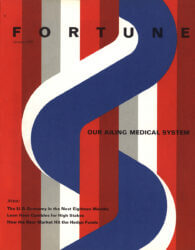March 5, 2024

Fortune-Telling Healthcare’s Dismal Future
January 1970 was a long time ago. Richard Nixon celebrated the first anniversary of his presidency. The Vietnam War was raging. The Paris Peace Accords, the Arab oil embargo, stagflation, wage and price controls, devaluation of the dollar, the creation of the Environmental Protection Agency and the Occupational Safety and Health Administration, Nixon’s historic trip to China, his massive re-election win, Watergate, Nixon’s secret tapes and his resignation were all still to come.
Also in that long-ago January, Disney World opened. The popular soap opera “All My Children” premiered as did the movie “MASH.” The Beatles held their last-ever recording session (without John Lennon) as Simon & Garfunkel released their last original album together (“Bridge Over Troubled Water”). The Kansas City Chiefs defeated the Minnesota Vikings in the last Super Bowl before the National and American Football Leagues merged. Muammar Gaddafi became Libya’s head of state after a coup d’état. Finally, the cost of New York City’s subway tokens jumped from 20 to 30 cents. Today, a one-way subway fare is $2.90.
At the time, Fortune magazine was America’s premier business journal. Published monthly, corporate titans displayed Fortune’s distinctive folio-sized issues on coffee tables while aspiring executives devoured the magazine’s content in cubicles. The Fortune 500 ranked the nation’s most valuable companies. When Fortune analyzed, business leaders took note.
Healthcare Beware
 In January 1970, Fortune zeroed in on healthcare. It published an investigative report titled “Our Ailing Medical System” with a provocative cover displaying a ravenous boa constrictor strangling the American flag, shown here. The cover’s designer, Walter Allner, made the wry observation that any resemblance between the snake and a dollar sign was purely coincidental. Then as now, money was at the center of American healthcare.
In January 1970, Fortune zeroed in on healthcare. It published an investigative report titled “Our Ailing Medical System” with a provocative cover displaying a ravenous boa constrictor strangling the American flag, shown here. The cover’s designer, Walter Allner, made the wry observation that any resemblance between the snake and a dollar sign was purely coincidental. Then as now, money was at the center of American healthcare.
Unfortunately, the healthcare boa constrictor has gotten much larger, more predatory and voracious since 1970. It has grown from 7% of GDP in 1970 to almost 18% today, far higher than all other advanced economies. Along the way, the medical-industrial complex has used its massive political and economic leverage to enrich itself at the expense of American society.
Despite being written over 50 years ago, Fortune’s opening commentary has a contemporary ring to it. Titled “It’s time to operate,” it portrays a chaotic, inefficient and ineffective U.S. healthcare system: [1]
American medicine, the pride of the nation for many years, stands now on the brink of chaos. To be sure, our medical practitioners have their great moments of drama and triumph. But much of U.S. medical care, particularly the everyday business of preventing and treating routine illnesses, is inferior in quality, wastefully dispensed, and inequitably financed.
Medical manpower and facilities are so maldistributed that large segments of the population, especially the urban poor and those in rural areas, get virtually no care at all — even though their illnesses are most numerous and, in a medical sense, often easy to cure.
Whether poor or not, most Americans are badly served by the obsolete, overstrained medical system that has grown up around them helter-skelter. … The time has come for radical change.
Remarkable! By changing the word “manpower” to “personnel,” we can apply the 1970s Fortune language verbatim to U.S. healthcare today. Unfortunately, the system’s structural flaws have magnified since then and contribute even more to the nation’s declining health status.
Seeds of Disruption
The healthcare marketplace is ripe for disruption because medicine’s organization and delivery of care have changed little since 1970. Then, like now, the industry’s core and essential activity was the pursuit of treatment volume at the expense of better health outcomes and customer experience. The January 1970 Fortune description of volume-driven care delivery still applies: [2]
Our hospital system is being severely strained, and money — unless accompanied by rational organization and careful controls — is not going to bring much relief. The strain comes from the fact that Medicare, Medicaid and most insurance schemes are designed in such a way as to encourage more frequent and longer stays in the hospital. Instead, they should hold out incentives for the use of less expensive facilities.
Despite the dire analysis, Fortune saw hope amid the darkness. With faith in America’s managerial prowess, its analysis makes the compelling argument that bringing “modern methods” to managing healthcare operations could deliver “good care to every American with little increase in cost.” The report observes with obvious relish that “the management of medical care has become too important to leave to doctors, who are, after all, not managers to begin with.”
As the saying goes, “Be careful what you wish for.” Professional administrators and managers have come to healthcare in a big way. Today, there are now 10 administrators for every physician. [3] These numbers are particularly staggering in contrast to other industries as outlined in a 2021 JAMA article citing research by McKinsey: [4]
To run any organization, a base of administration is necessary. A typical U.S. services industry (for example, legal services, education, and securities and commodities) has approximately 0.85 administrative workers for each person in a specialized role (lawyers, teachers and financial agents).
Despite the expansive increases in healthcare administration, or perhaps because of them, U.S. healthcare costs have continued to spike upward, even as Americans’ collective health status has sputtered and by many measures declined.
The late Charlie Munger, Warren Buffett’s long-time investment partner, observed, “Show me an incentive and I’ll show you an outcome.” [5] Munger further noted, “If you have a dumb incentive system, you get dumb outcomes.”
Unfortunately, U.S. healthcare proves Munger’s thesis. “Modern methods” of healthcare management focus their considerable energy on exploiting perverse economic incentives.
Healthcare’s “dumb” incentive system enriches self-interested industry incumbents without delivering value to consumers. A lack of market accountability combined with a lax regulatory environment creates the underlying conditions that enable incumbents to prosper. With little punishment, there are often lucrative incentives for inefficient and ineffective care delivery. Conversely, with little reward there are often negative financial consequences for pursuing health promotion and value-based care delivery.
Healthcare’s perverse economic incentives explain why technological advances, unlike in other industries, have increased rather than lowered costs. They also explain the profound maldistribution of facilities and practitioners, which can limit care access and care coordination. These perverse incentives further and cynically explain why the healthcare industry spends multiples more than all other industries on lobbying. They do it to sustain a favorable legislative and regulatory framework that fills their coffers.
The Time for Reform Is Now
Fortune-telling is an inexact science, particularly when it comes to healthcare reform. Even President Nixon declared in February 1974 that “comprehensive health insurance is an idea whose time has come in America.” His administration proposed universal health insurance with the support of the American Medical Association, hospitals and the insurance industry. Needless to say, Nixon’s vision hasn’t materialized.
The healthcare industry, however, cannot fight gravity forever. Consumerism, technological advances and pro-market regulatory reforms are so powerful and coming so fast that status-quo healthcare cannot forestall their ascendance. Properly harnessed, these disruptive forces have the collective power necessary for U.S. healthcare to finally achieve the 1970 Fortune magazine goal of delivering “good care to every American with little increase in cost.”
—This commentary originally appeared in hfma.
- “It’s Time to Operate,” Fortune 81 (January 1970), 79.
- Fortune, January 1970.
- Fieseher, J., “10 administrators for every 1 doctor. We deserve a better healthcare system,” Foster’s Daily Democrat, April 1, 2022.
- Sahni, N., Cutler, D., and Carrus, B., “Administrative simplification and the potential for saving a quarter-trillion dollars in health care,” JAMA Network, Oct. 20, 2021.
- Warren Buffet Archive, 2016 Annual Meeting, April 30, 2016, 1:00 p.m. EDT.





